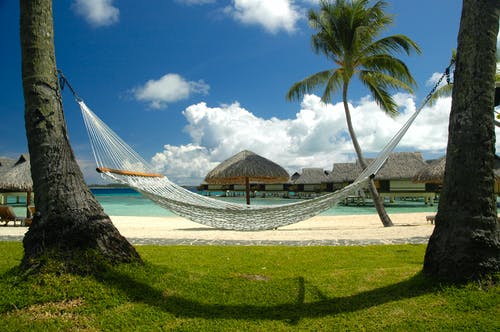This article will help you learn everything about camping with hammocks in Canada, from how to use them properly to where to place them.
It’s one thing to have a hammock hanging down like an artist, but how about hammock camping?
You may be able to hang your hammock from trees, but you don’t know how to do it. What about the practical survival tips that will make your camping experience exceptional?
Here are 10 tips and tricks for hammock camping that will make you forget about reality.
If you’re not home, tell your family!
Hammock Camping Tips For Beginners
Are you curious to find out more? These are some tips to make hammock camping a memorable experience.
TIP 1 TREE-SAVER STRIPES
You can make minimal impact on the campsite and wildlife, which is one of the advantages of hammock camping. Since you aren’t pitching a tent, you don’t need to dig a trench or level the ground.
However, you must hang your hammock from trees.
Hammock tree straps are the only way to achieve this without causing damage to the trees. Because they reduce damage to the bark or cambium layer of trees, these are known as tree-saver strings.
Make sure to use wide polyester tree straps (about 1 to 2-inches) that wrap around trees, distribute weight and minimize girdling effects. Never use any non-tree-friendly materials, such as zip cords, nails, or screws.
TIP 2 DO NOT HANG YOUR HAMMOCK ABOVE DEAD TREES
The dead trees are simply not strong enough to support your weight.
They can break or fall and cause serious damage to the area. Hang your 2 person hammock with stand only on strong, healthy, thick trees.
You can check for dead branches if you are unsure whether a tree has died.
Also, you can check for fallen objects. While you are sleeping, you don’t want to get hit in the head by an acorn or worse, a dead tree.
TIP 3 HANG YOUR MOCK AT LEAST 200 FT AWAY FROM A WATER SURFACE
Your safety and the safety of your unique plant habitats near water are paramount.
The riparian region is the area between land, a stream, or a river.
Important for soil stability and prevention of land erosion, the river banks, and river margins are known as riparian plants.
You are welcome to relax at the beach. However, if you plan to spend time there, please respect the land and flora.
TIP 4 HANG YOUR MOCK AT THE RIGHT HEIGHT (AND WITH A GOOD SAGA)
Hang your hammock at an appropriate height for comfort. This will make it easy to sit comfortably in your hammock and not worry about flipping.
A deeper sag is a way to avoid discomfort and prevent hammock flipping.
Hang your hammock at a 30-degree angle to the anchor points.

Deep sags lower the center of gravity and improve the stability of your hammock. A lower center of gravity helps to prevent the annoying cocooning effect that is common in hammocks with tight hangs.
Hammocks should be comfortable and relaxing. They are not meant to make you feel deprived or eat you. This advice will ensure that you have a relaxing time every time.
TIP 5 – PROPERLY SCHECK FOR HIDDEN DAMAGERS AND WILDLIFE
Dead trees and trees that aren’t strong enough to support your weight are hidden dangers. Trees should not be dead and large enough to wrap your hands around them completely.
Also, there should be minimal ground between trees.
You should be aware of roots and lichen, which could cause you to trip or slip.
You should also check for hidden dangers like wasp nests or poisonous plants. You might consider moving to another campsite if you find any dangers.

TIP 6 – RESEARCH OUR CAMPING GROUND
You can do your research about the campground before you go, regardless of whether you are camping at a Canadian campsite that is free or paid for. You should double-check to make sure hammock camping is allowed.
This may seem odd, but some areas might have endangered trees or trees not strong enough for hammock campers.
You should always verify with your local government before using hammocks in parks.
TIP 7 – BREAK YOUR HAMMOCK WHENEVER IT’S LEFT (EVEN IF IT IS JUST FOR A HOUR OR LESSER)
Break down your hammock if you are going on a hike, swimming, or paddling trip, or if you leave your campsite unattended for a brief time. This will keep animals and children safe from getting caught in your hammock.
Keep in mind that you are sharing the land and other animals. Make sure you leave no trace and keep your campsite clean.
This tip is great for any type of camping. You will leave a smaller footprint if you don’t have as much stuff.
TIP 8 USE A HAMMOCK WITH BUILT-IN MOSQUITO NETTING
Moths, midges, and flies can all ruin a good night of sleep in a hammock.
A hammock with a mosquito net is a great way to keep those pesky bugs out of your ears and on your skin.
You can protect yourself from any critters by using a hammock with built-in netting.
You can stay safe from their stingers, and enjoy your peaceful sleep under the stars.
TIP 9 USE a DRIP LINE
A drip line can be used in conjunction with a tarp to keep your hammock dry during rainy nights. Attach a rope or string to your hammock suspension cord. Leave two ends hanging down.
For extra protection against the rain, you can attach drip lines to your hammock tarp suspension.
Drip lines stop water from getting down the suspension and soaking your hammock.
Rainwater will not flow down to your hammock. Instead, it will flow to the bottom of the drip lines.
TIP 10 – LAY DIAGONALLY ABROAD YOUR HAMMOCK, AND RISE YOUR FOOT EXTENDED
Here’s how to properly sleep in your hammock: Lay on the diagonal
Instead of sleeping in the hammock’s direction, tilt your body slightly to the side. This will allow you to sleep in an ergonomically flat position.
Hang the foot of the hammock 8-10 inches higher than the opposite side to prevent your body from sliding into the middle of your hammock.
These hammock tips and tricks will help you make the most of your summer camping experience. If you are a seasoned hammock camper, you can make it a relaxing and comfortable experience. These expert tips will help you go from a beginner to a pro at hammock camping.





